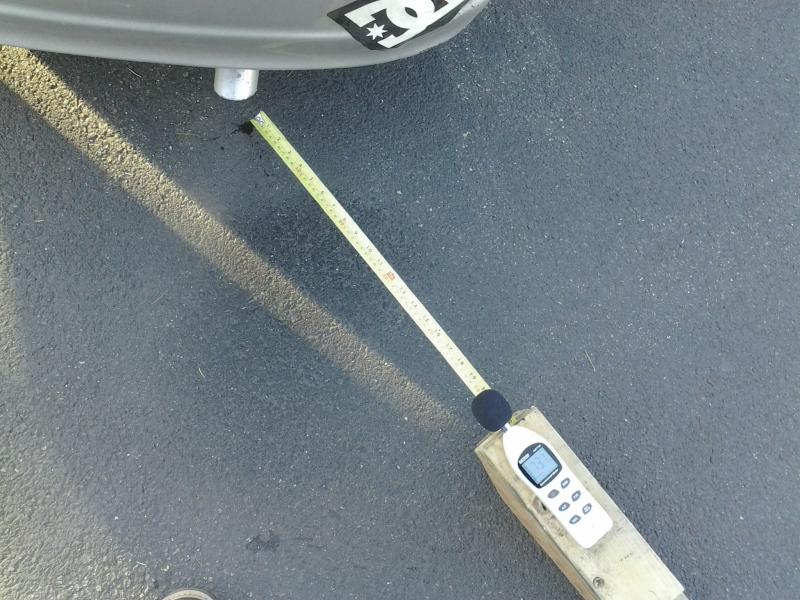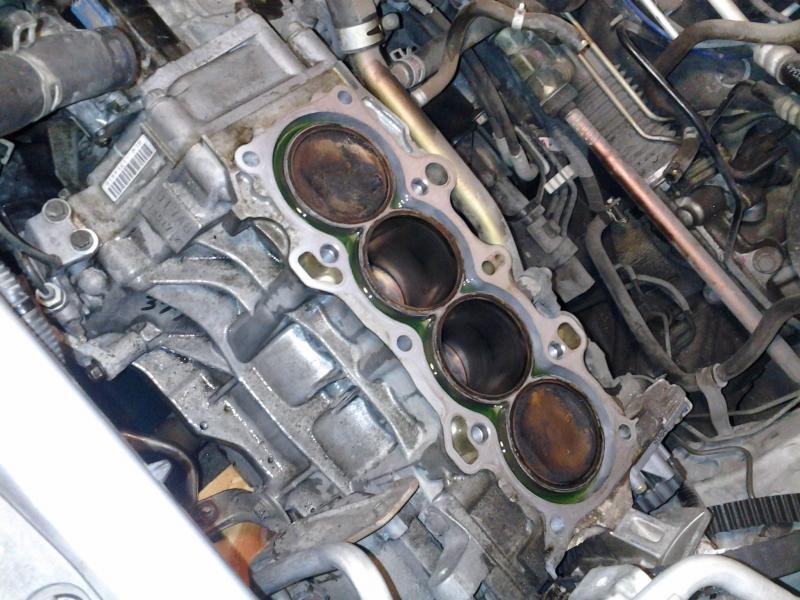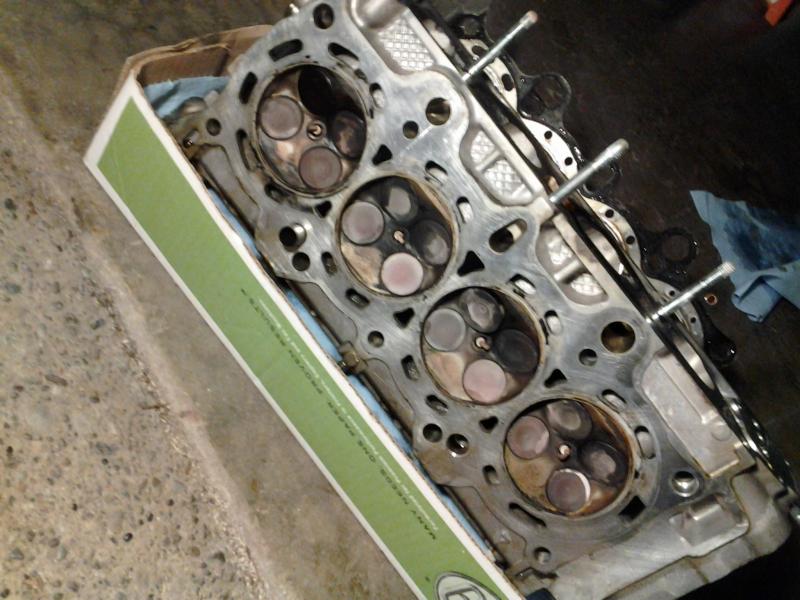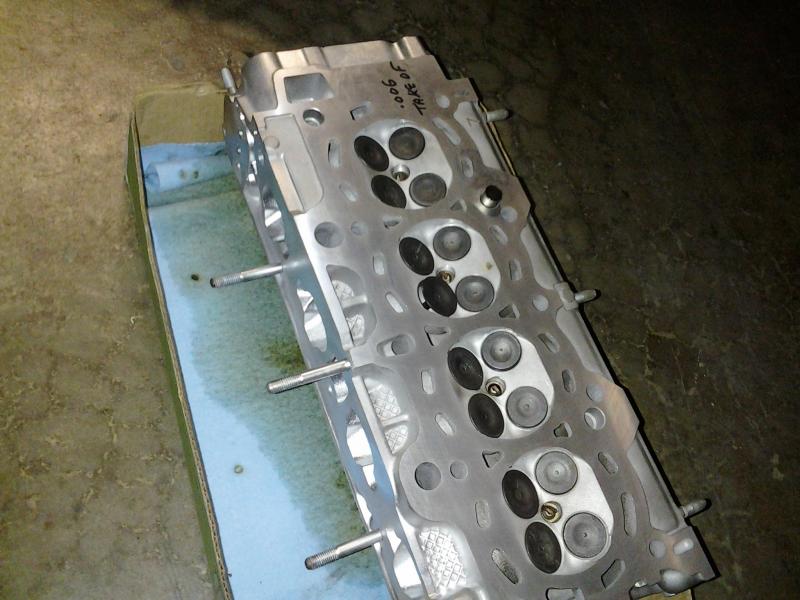 01-27-2014, 06:28 PM
01-27-2014, 06:28 PM
|
#51 (permalink)
|
|
.........................
Join Date: Aug 2009
Location: Buckley, WA
Posts: 1,597
Thanks: 391
Thanked 488 Times in 316 Posts
|
Quote:
Originally Posted by aerohead

That's some really elegant engineering!  |
Thanks!
Each step is 18 inches long which means it's low enough to fit under the nose of all but the lowest cars. At 10 inches wide, there is very little risk off falling off the side, and it's very sturdy, safely holding up the wife's Tahoe. I plan to add a bevel to the first step and rubber pads underneath because on my very smooth garage floors, they can slide around with a light, RWD car (Corvette). FWD is no problem.
I can't claim it as an original idea, though. I basically copied someone else's ramps, just changed the dimensions a bit to make sure I would have clearance and added a stop on the top step. They were cheaper than a set of steel ramps from Harbor Freight and are a lot easier to use. The individual steps give you feedback on how high up the ramp you are.
The only downside to these is that they are heavy (35-40lbs each). It's basically two 2"x10"x8' planks per side.
|
|
|

|
|
The Following User Says Thank You to darcane For This Useful Post:
|
|
 Today Today
|
|
|
|
 Other popular topics in this forum...
Other popular topics in this forum...
|
|
|
|
 02-05-2014, 04:10 PM
02-05-2014, 04:10 PM
|
#52 (permalink)
|
|
.........................
Join Date: Aug 2009
Location: Buckley, WA
Posts: 1,597
Thanks: 391
Thanked 488 Times in 316 Posts
|
So, I've gotten some flak about my straight pipe being obnoxiously loud by a couple people on this forum. However, none have actually heard it and I believe that it is OK as is. So, how to verify?
SAE J1169.
This is the very specific standard for measuring the sound level of a light passenger vehicle's exhaust. The test is performed at 75% of the engines peak horsepower rpm, about 4500 for my Civic. The sound level meter must be 0.5m(20") from the exhaust outlet 45° from directly behind the outlet. The sound level meter must be parallel to the ground at the same height as the exhaust tip, but no less than 0.2m (8") from the ground. It should be in a wide open area with no wind, and no surfaces to reflect sound back to the meter and tested using an "A" weighting on the meter. I did my best to eliminate all other variables, but I did have some wind today.

Numbers:
Each measurement was made three times and averaged.
At an idle, I measured 73dB
At 2500rpm, I measured 94dB
At 4500rpm, I measured 97dB
OK, so is it legal? Well... no. WA state actually has no noise level requirements, it just states that you must have a muffler and it must not be any louder that stock. So, really any aftermarket exhaust is illegal per state law. Most states that do have a limit, put it at 95dB, and I am right on the border of that. As I drive this car for economy, I believe this is the first time I've had this engine at 4500rpm. I normally shift between 2000 and 2500rpm, so it is below the generally accepted levels in my normal rpm range
So, is it louder than stock? Yes.
Is it loud enough to bother other people? I'm comfortable saying no here. And I have no concerns about getting ticketed for it.
Especially since the farther away you get, the quieter it is. As you can see, the reading is taken very close to the exhaust outlet, and sound levels drop quickly with distance as it follows the inverse-square law. Just 5 feet away, it drops down to 62dB at idle. That's less than half as loud and about the same sound level as a normal conversation. While testing I was able to tell my F-I-L commands without needing to yell, and I felt no need for hearing protection while observing the sound level meter. |
|
|

|
|
The Following 3 Users Say Thank You to darcane For This Useful Post:
|
|
 02-05-2014, 04:52 PM
02-05-2014, 04:52 PM
|
#53 (permalink)
|
|
Batman Junior
Join Date: Nov 2007
Location: 1000 Islands, Ontario, Canada
Posts: 22,541
Thanks: 4,085
Thanked 6,989 Times in 3,619 Posts
|
Science!
|
|
|

|
 02-05-2014, 06:09 PM
02-05-2014, 06:09 PM
|
#54 (permalink)
|
|
Master EcoModder
Join Date: Jan 2008
Location: Sanger,Texas,U.S.A.
Posts: 16,509
Thanks: 24,517
Thanked 7,436 Times in 4,817 Posts
|
straight pipe
If we had the EcoModder chassis dyno we could test your car under load.Your decibel reading might be different if the engine was really 'working.'
Some messengers have reported a need for back pressure for scavenging at low load,and less restriction as you climb the power curve.
Some motorcycles have dyno-tuned 'Smart' exhaust systems which incorporate a butterfly valve which is computer driven,always holding the valve in the 'sweet-spot' according to test cell development mapping.
I raced a Honda in high school and it's power fell off without the factory muffler.A reverse-cone megaphone exhaust provided a nice balance between low and high end performance.Some of my friends fathers were rocket scientists and they could explain the physics involved.Kind of tricky. 
__________________
Photobucket album: http://s1271.photobucket.com/albums/jj622/aerohead2/
|
|
|

|
 02-05-2014, 07:44 PM
02-05-2014, 07:44 PM
|
#55 (permalink)
|
|
.........................
Join Date: Aug 2009
Location: Buckley, WA
Posts: 1,597
Thanks: 391
Thanked 488 Times in 316 Posts
|
Quote:
Originally Posted by aerohead

If we had the EcoModder chassis dyno we could test your car under load.Your decibel reading might be different if the engine was really 'working.'
|
That is correct. It would also be louder at peak power output. I don't believe SAE J1169 is intended to be a measure of the peak dB that might be heard by a person, but is rather a specific test to compare one car to another. While it would be louder under load, it is unlikely that anyone will have their head 0.5m from my exhaust pipe while I am accelerating under load.
So, cars that measure 95dB and lower under this specific test are considered to be acceptable under all conditions even thought they may exceed 95 dB in other conditions.
Quote:
Originally Posted by aerohead

Some messengers have reported a need for back pressure for scavenging at low load,and less restriction as you climb the power curve.
Some motorcycles have dyno-tuned 'Smart' exhaust systems which incorporate a butterfly valve which is computer driven,always holding the valve in the 'sweet-spot' according to test cell development mapping.
I raced a Honda in high school and it's power fell off without the factory muffler.A reverse-cone megaphone exhaust provided a nice balance between low and high end performance.Some of my friends fathers were rocket scientists and they could explain the physics involved.Kind of tricky.  |
There is never any condition where back pressure is desired.
Scavenging is the process where a pulse of exhaust gases from another cylinder (or an earlier cycle in a single cylinder engine) will cause a vacuum behind it, and if the timing is just right to coincide with the exhaust valve opening, it assists the evacuation of the cylinder. This is a "tuned" system and only works well in a narrow rpm band.
Large diameter exhaust tubing will improve scavenging at higher RPMs resulting in more peak horsepower. However, it reduces the scavenging at low RPMs and reduce low end torque.
Small diameter exhaust tubing will improve scavenging at low RPMs resulting in more low end grunt. But, it will be restrictive at high RPMs and reduce peak power. This would generally be considered to have "high backpressure" but the reality is that it reduces the pressure at the exhaust valve at low RPMs
Improved scavenging means less pressure at the exhaust valve. In no case do you want more pressure, but you have a tuned system and you can adjust where it is most effective at reducing pressure. Ideally, you could have great scavenging at all RPMs, but it doesn't work that way.
To put it another way: an appropriately designed header has less backpressure than if you had no header/exhaust manifold at all...
So, while the loss of the muffler may have moved the RPM band for peak scavenging, I don't believe it moved it much considering the long length of the overall system. Certainly not enough that I could measure, and there was no detectable change in my fuel economy.
Your old Honda motorcycle would be more susceptible to exhaust modifications for two reasons. One, the short length of the exhaust system. And two, the carburetor's inability to adjust the fuel mixture for it.
P.S. I happen to have a Mechanical Engineering degree and took courses on Internal Combustion Engines for what it is worth.
Last edited by darcane; 02-05-2014 at 07:46 PM..
Reason: Punctuation is important.
|
|
|

|
|
The Following 4 Users Say Thank You to darcane For This Useful Post:
|
|
 02-06-2014, 12:06 AM
02-06-2014, 12:06 AM
|
#56 (permalink)
|
|
EcoModding Apprentice
Join Date: Apr 2011
Location: Canyon Lake, Texas
Posts: 222
none - '98 Honda Civic HX none - '00 Chevy (Geo) Metro base none - '00 Saturn SL1 base
Thanks: 126
Thanked 77 Times in 50 Posts
|
Good post.
|
|
|

|
 02-06-2014, 06:33 PM
02-06-2014, 06:33 PM
|
#57 (permalink)
|
|
Master EcoModder
Join Date: Jan 2008
Location: Sanger,Texas,U.S.A.
Posts: 16,509
Thanks: 24,517
Thanked 7,436 Times in 4,817 Posts
|
scavenging
Quote:
Originally Posted by darcane

That is correct. It would also be louder at peak power output. I don't believe SAE J1169 is intended to be a measure of the peak dB that might be heard by a person, but is rather a specific test to compare one car to another. While it would be louder under load, it is unlikely that anyone will have their head 0.5m from my exhaust pipe while I am accelerating under load.
So, cars that measure 95dB and lower under this specific test are considered to be acceptable under all conditions even thought they may exceed 95 dB in other conditions.
There is never any condition where back pressure is desired.
Scavenging is the process where a pulse of exhaust gases from another cylinder (or an earlier cycle in a single cylinder engine) will cause a vacuum behind it, and if the timing is just right to coincide with the exhaust valve opening, it assists the evacuation of the cylinder. This is a "tuned" system and only works well in a narrow rpm band.
Large diameter exhaust tubing will improve scavenging at higher RPMs resulting in more peak horsepower. However, it reduces the scavenging at low RPMs and reduce low end torque.
Small diameter exhaust tubing will improve scavenging at low RPMs resulting in more low end grunt. But, it will be restrictive at high RPMs and reduce peak power. This would generally be considered to have "high backpressure" but the reality is that it reduces the pressure at the exhaust valve at low RPMs
Improved scavenging means less pressure at the exhaust valve. In no case do you want more pressure, but you have a tuned system and you can adjust where it is most effective at reducing pressure. Ideally, you could have great scavenging at all RPMs, but it doesn't work that way.
To put it another way: an appropriately designed header has less backpressure than if you had no header/exhaust manifold at all...
So, while the loss of the muffler may have moved the RPM band for peak scavenging, I don't believe it moved it much considering the long length of the overall system. Certainly not enough that I could measure, and there was no detectable change in my fuel economy.
Your old Honda motorcycle would be more susceptible to exhaust modifications for two reasons. One, the short length of the exhaust system. And two, the carburetor's inability to adjust the fuel mixture for it.
P.S. I happen to have a Mechanical Engineering degree and took courses on Internal Combustion Engines for what it is worth.
|
I have the same degree as you.We may have had to use the same textbooks and labs.I suspect so.
The fathers in the neighborhood had sons who raced TT scrambles and motocross and designed systems for the bikes.When we would ask about the systems,they would get into the blow-downs,compressions,reflections,rarifactions,deflec tions,internal velocities,pressure gradients 'n such of the exhaust systems,something deeper than anything I ever experienced in I.C.Lab.The 2-stroke stuff was way over my head.
They also mentioned that this activity was a lot like algebra,and that whatever you did to one side of the equation (exhaust),that you had to balance it with something on the opposite side (induction).So I kinda deferred to their knowledge.
Kevin Cameron,who does a regular 'TDC' article in Cycle World did the piece on the 'Smart' exhaust system.He wrote as if this system combined the best of both worlds with respect to low and high-speed operation.
Active noise cancellation technology would allow you to run an open pipe with no noise whatsoever,although I don't see much of that offered in the market place.Looks like there's still room for improving the typical system.
__________________
Photobucket album: http://s1271.photobucket.com/albums/jj622/aerohead2/
|
|
|

|
 08-15-2014, 06:37 PM
08-15-2014, 06:37 PM
|
#58 (permalink)
|
|
.........................
Join Date: Aug 2009
Location: Buckley, WA
Posts: 1,597
Thanks: 391
Thanked 488 Times in 316 Posts
|
Off with Her Head!!

My Civic has been decapitated!
After fighting with a leaky headgasket for a while, I finally followed Daox's lead and got the head pulled off to deal with it. There's a little carbon buildup on the pistons. Hmm...

Cylinder 4 seems to some black soot between the cylinder and the coolant passages. Not shown, but the gasket shows some small signs of deterioration on all four cylinders. It was definitely time to replace.
I took the head to a machine shop and he verified there were no cracks...
but also verified I had multiple valves that were not sealing and the valve seals were letting oil past on several valves (confirming that burnt oil odor I thought I smelled on startup). No quick resurface here, the head is getting a full rebuild.
Hopefully this translates to a significant uptick in mpgs afterwards...
|
|
|

|
|
The Following 2 Users Say Thank You to darcane For This Useful Post:
|
|
 08-22-2014, 02:19 PM
08-22-2014, 02:19 PM
|
#59 (permalink)
|
|
.........................
Join Date: Aug 2009
Location: Buckley, WA
Posts: 1,597
Thanks: 391
Thanked 488 Times in 316 Posts
|
And... the head is done.

Cleaned, inspected, resurfaced, valve job, new valve seals. Once a few more parts show up, I'll get it put back on. The black marker indicates it needed .006" to get it back to being flat. |
|
|

|
|
The Following User Says Thank You to darcane For This Useful Post:
|
|
 08-22-2014, 02:45 PM
08-22-2014, 02:45 PM
|
#60 (permalink)
|
|
Cyborg ECU
Join Date: Mar 2011
Location: Coastal Southern California
Posts: 6,302
Thanks: 2,374
Thanked 2,176 Times in 1,471 Posts
|
Very pretty. 0.006 refers to valve lash/clearance? 0.006 would be tihter than spec just a hair, yes?
__________________
See my car's mod & maintenance thread and my electric bicycle's thread for ongoing projects. I will rebuild Black and Green over decades as parts die, until it becomes a different car of roughly the same shape and color. My minimum fuel economy goal is 55 mpg while averaging posted speed limits. I generally top 60 mpg. See also my Honda manual transmission specs thread.


|
|
|

|
|